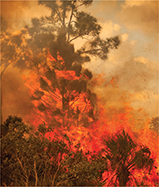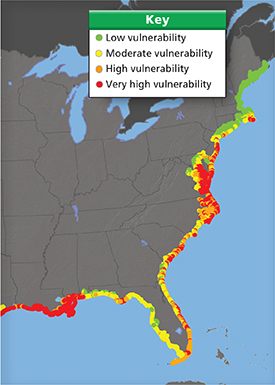Effects of Global Warming
An increase in global temperatures by just a few degrees may not seem like a lot. In the past, however, such increases caused significant changes to Earth's surface. The effects of global warming include droughts and forest fires, as shown in Figure 39. Other significant problems include desertification, changes to the biosphere, melting glaciers, rising sea levels, and regional changes in temperature and precipitation.
When Earth's climate gets warmer, the effects can vary greatly from region to region. Ocean and air currents can change, greatly heating some places and even cooling others. For example, the Antarctic Peninsula has been warming at the rapid rate of 0.5°C every 10 years, but much of the interior of Antarctica has actually been cooling. In general, however, land temperatures are rising much faster than ocean temperatures because more energy is needed to raise the temperature of water than that of rock.
When environments change slowly over millions of years, plant and animal life evolves to adapt. If these environments change too much, too quickly, many species will become extinct. In the case of global warming, only species that can adapt to warmer conditions will survive.
As you already know, when temperatures rise, ice tends to melt. There is evidence of this happening on a global scale: mountain glaciers worldwide are melting at an increasing rate; ice sheets in Antarctica are breaking up and flowing to the ocean; and the amount of Arctic winter sea ice at the North Pole is shrinking. At the same time, sea levels are rising, because of both the melting of continental ice and the thermal expansion of seawater as it warms. Since the end of the last ice age, sea levels have risen 122 meters. As glaciers continue to melt, sea levels will continue to rise. This rise poses a threat to the many people who live in coastal areas. In Figure 40, you can identify many low-lying parts of the eastern United States that are vulnerable to rising sea levels.
Figure 39 When global temperatures rise, some regions get very warm and dry. This can lead to water shortages, which make the land more vulnerable to forest fires.

Figure 40 This satellite image shows how sea level rise could affect the eastern United States.





